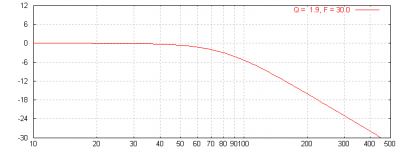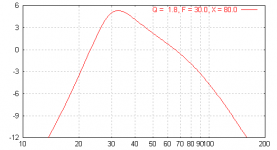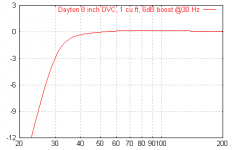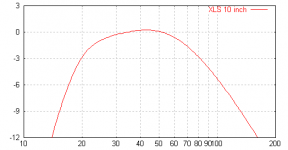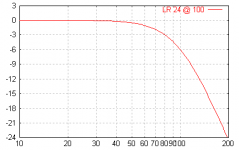Right,
You can have the crossover Q anything you want, and yes it is different from the boost Q.
Q=0.707 is the 2nd order butterworth value. Q=0.5 is 2nd order Linwitz Riley
If you call the crossover B(f) as above:
B(f) = 1/sqrt((1-fc2)^2+(fc2/Q^2))
You can square B(f) and if the crossover Q is 0.707, you get a 4th order Linkwitz Riley slope.
LR4(f) = B(f)^2 = 1/((1-fc2)^2+(fc2/0.707^2))
Now you need to add in the woofer equation and you are golden. You are then well on your way to modeling speakers.
Have fun!
You can have the crossover Q anything you want, and yes it is different from the boost Q.
Q=0.707 is the 2nd order butterworth value. Q=0.5 is 2nd order Linwitz Riley
If you call the crossover B(f) as above:
B(f) = 1/sqrt((1-fc2)^2+(fc2/Q^2))
You can square B(f) and if the crossover Q is 0.707, you get a 4th order Linkwitz Riley slope.
LR4(f) = B(f)^2 = 1/((1-fc2)^2+(fc2/0.707^2))
Now you need to add in the woofer equation and you are golden. You are then well on your way to modeling speakers.
Have fun!
Ron E said:Right,
You can have the crossover Q anything you want, and yes it is different from the boost Q.
Q=0.707 is the 2nd order butterworth value. Q=0.5 is 2nd order Linwitz Riley
If you call the crossover B(f) as above:
B(f) = 1/sqrt((1-fc2)^2+(fc2/Q^2))
You can square B(f) and if the crossover Q is 0.707, you get a 4th order Linkwitz Riley slope.
LR4(f) = B(f)^2 = 1/((1-fc2)^2+(fc2/0.707^2))
Now you need to add in the woofer equation and you are golden. You are then well on your way to modeling speakers.
Have fun!
Right arm!
The manufacture's spec sheets for the Part Express plate amps don't say what kind of slope the crossovers have. Do you reckon it's 2nd oder Butterworth?
Ron E said:
Remember, a lowpass passes the lows and cuts the highs, and a highpass passes the highs and cuts the lows. The peaking lowpass filter here cuts the lows below the tuning frequency and protects the vented driver below resonance. This is better known as a 6th order alignment.
Note that this should read:
The peaking highpass filter.........
This is so way majorly cool!
I implemented the ported and passive radiator responses. For starters, I verified that I got lucky on my XLS 10" sub with the passive radiator. It's well behaved (in simulation) to 30 Hz. That's with the default 6dB boost at 30 Hz that the amp comes with.
But wait, there's more. Suppose I change the resistors in the amp to get a different bass boost curve. I can go to 20 Hz easily. The only question is how much I want it to roll off around 20-30 Hz to acount for room lift. Look at the attached chart. Bear in mind that I need a crossover point between 70 and 80 Hz.
I used a boost with Q = 1.3 at 19 Hz, set the crossover to 55 Hz [sic], and turned the volume up 8 dB. Voila!
I implemented the ported and passive radiator responses. For starters, I verified that I got lucky on my XLS 10" sub with the passive radiator. It's well behaved (in simulation) to 30 Hz. That's with the default 6dB boost at 30 Hz that the amp comes with.
But wait, there's more. Suppose I change the resistors in the amp to get a different bass boost curve. I can go to 20 Hz easily. The only question is how much I want it to roll off around 20-30 Hz to acount for room lift. Look at the attached chart. Bear in mind that I need a crossover point between 70 and 80 Hz.
I used a boost with Q = 1.3 at 19 Hz, set the crossover to 55 Hz [sic], and turned the volume up 8 dB. Voila!
Attachments
Ron E said:Before you go too nuts with the bass boost, you might want to model excursion. Just because the EQ'd woofer will go flat to 20Hz doesn't mean it will handle much power there.. Make sure to apply boost at the tuning frequency.
Glad you are enjoying yourself!
Good advice. I might also want to learn about calculating phase. Can you recommend a book that has this stuff in it?
Ron E said:Before you go too nuts with the bass boost, you might want to model excursion. Just because the EQ'd woofer will go flat to 20Hz doesn't mean it will handle much power there.. Make sure to apply boost at the tuning frequency.
The tuning frequency is indeed right around 20 Hz. I'm going to change those resistors to move the boost level down to 20 Hz.
Dave Jones said:
The tuning frequency is indeed right around 20 Hz. I'm going to change those resistors to move the boost level down to 20 Hz.
... or remove the boost alltogether. I'm going to start another thread. See XLS 10" -- boost?
I posted it earlier:
"You can square B(f) and if the crossover Q is 0.707, you get a 4th order Linkwitz Riley slope.
LR4(f) = B(f)^2 = 1/((1-fc2)^2+(fc2/0.707^2))
"
The LR is down 6dB at fc2.
---in LaPlace Notation----------------------------------
2nd order highpass is:
sn^2/(sn^2+sn/Q+1)
2nd order lowpass is
1/(sn^2+sn/Q+1)
sn is normalised complex frequency sn=s/sc
sc=crossover frequency
substitute s=jw
for frequency response:
take magnitude of numerator and denominator
magnitude of numerator or denominator = sqrt(realpart^2+imaginary^2)
for phase response (in radians):
phase = arg(numerator)-arg(denominator)
cheers.....
"You can square B(f) and if the crossover Q is 0.707, you get a 4th order Linkwitz Riley slope.
LR4(f) = B(f)^2 = 1/((1-fc2)^2+(fc2/0.707^2))
"
The LR is down 6dB at fc2.
---in LaPlace Notation----------------------------------
2nd order highpass is:
sn^2/(sn^2+sn/Q+1)
2nd order lowpass is
1/(sn^2+sn/Q+1)
sn is normalised complex frequency sn=s/sc
sc=crossover frequency
substitute s=jw
for frequency response:
take magnitude of numerator and denominator
magnitude of numerator or denominator = sqrt(realpart^2+imaginary^2)
for phase response (in radians):
phase = arg(numerator)-arg(denominator)
cheers.....
- Status
- This old topic is closed. If you want to reopen this topic, contact a moderator using the "Report Post" button.
- Home
- Loudspeakers
- Multi-Way
- How to figure FR with bass boost?
